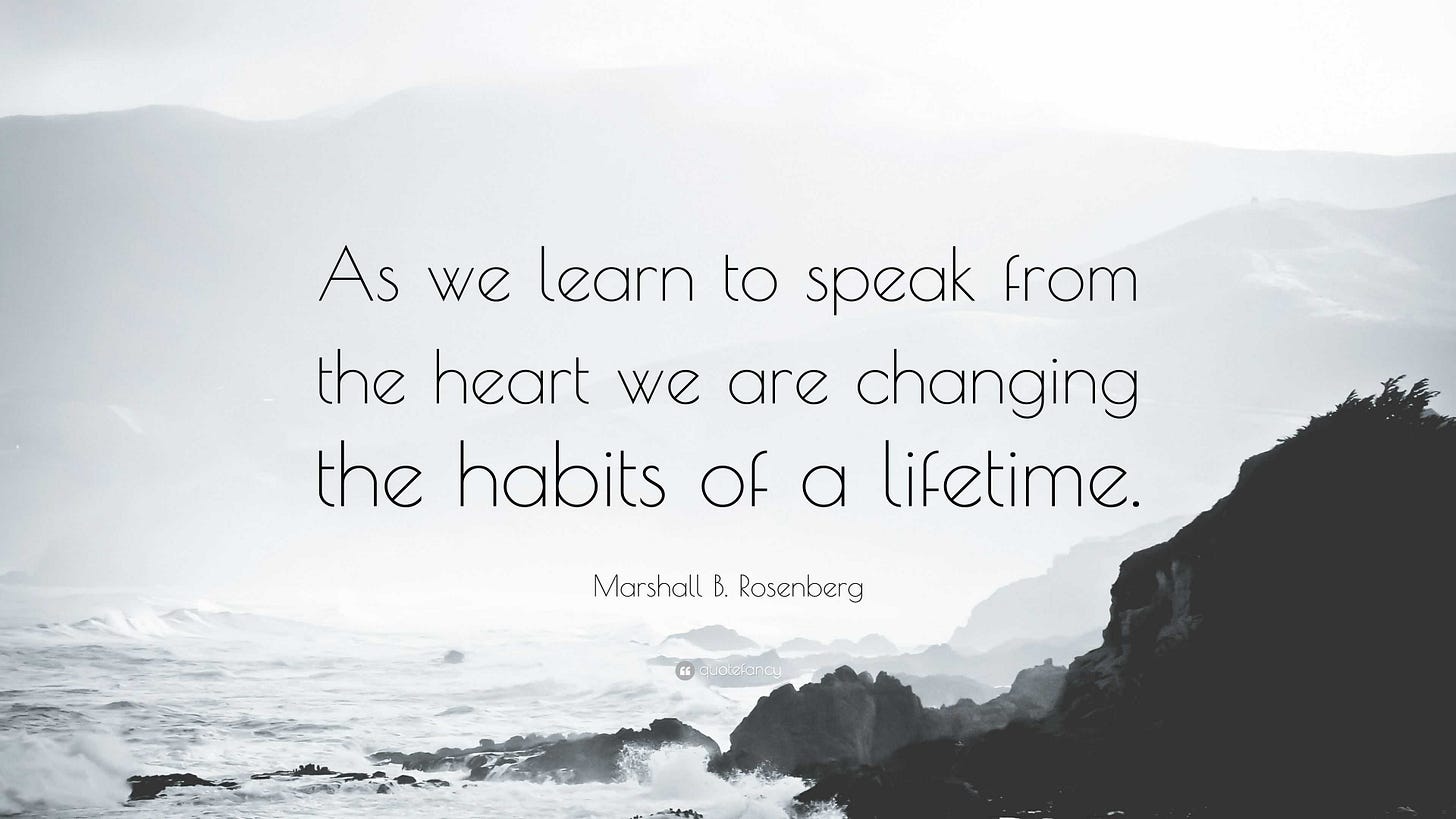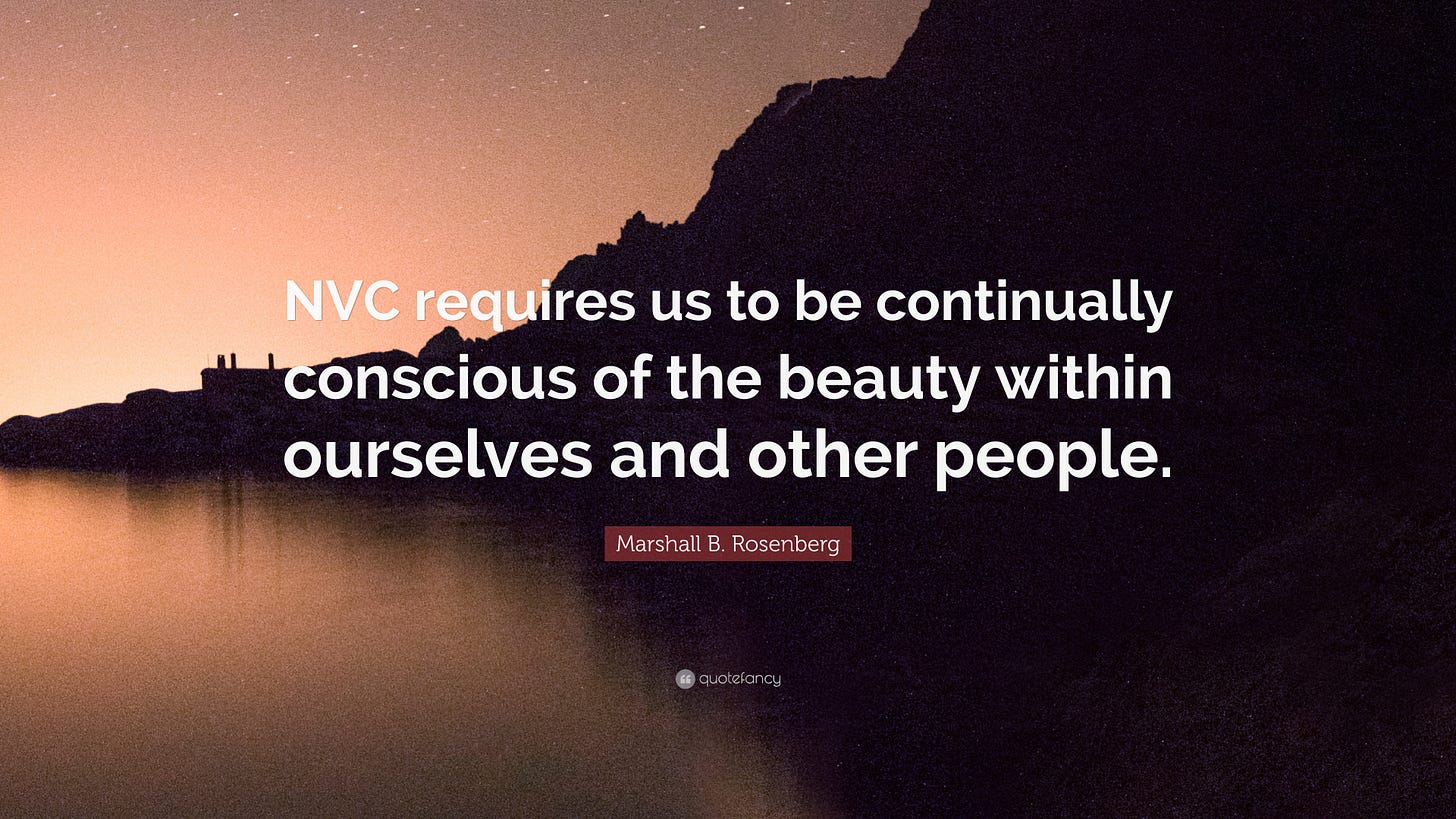People: We need a better language
Here's why I'm clinging to Nonviolent Communication right now.

Cooking, scrolling. Scrubbing, scrolling. Picking up, dropping off. Scrolling, scrolling, scrolling.
Scrolling to catch up on thousands of years of conflict and war in the Middle East. Scrolling to stay on top of the latest new. Scrolling to bear witness. Scrolling to find a way to truly understand how to think and how to act. Scrolling in search of hope.
‘But wait, I’m a parent!’ my brain reminds me. ‘An essential worker, they say. Raising the next generation to be kind, empathetic and emotionally intelligent is exactly what the world needs right now. I’m doing exactly what I need to be doing in this moment.’
Relief washes over me.
Then, like clockwork, a tiny human tackles my leg.
“Mama, mama, MAAAAMAAAAA! I’m huuuuuungry. I want juice. No, milk. And cereal. I want milk and cereal. And juice!”
A wave of the graphic images I just consumed flood my brain. I want to scream.
“NO! I’ve been serving food all morning. Go find something to do, please! Leave me alone!”
Oh wait, I did scream that. Damn. If the future really depends on my mindful/gentle/conscious/peaceful/positive parenting skills, we are doomed.
Or, maybe not.
I know I’m not the only parent riding this pendulum swing. Many of us are trying to read all the “right” books; listen to all the “right” podcasts; follow all the “right” social media accounts; trying hard to replace off-the-cuff consequences and punishments with empathy and expert-approved scripts; attempting to raise kids on the “right side of history” while navigating broken systems, divisive politics and a virtual front row seat to unimaginable violence. Then, burying our heads in a sea of shame as soon as all those “rights” fly out the window and desperation and rage take over.
I know I am one of many, many parents today who whole-heartedly believe in the power of raising a better future through our parenting practices, while feeling wholly overwhelmed by the weight of that mission and the lack of support along the way.
But there is one thing keeping me hopeful right now.
Nonviolent Communication
The late psychologist Marshall B. Rosenberg, Ph.D. developed Nonviolent Communication (NVC) throughout the 1960s and 70s. Rosenberg himself grew up in a time and place rife with race wars and antisemitism and dedicated the rest of his life to understanding two key questions: “What happens to disconnect us from our compassionate nature, leading us to behave violently and exploitatively? And conversely, what allows some people to stay connected to their compassionate nature under even the most trying times?”
His quest to answer those questions led him to develop Nonviolent Communication — what he deemed “the language of life.” In his audio book, Nonviolent Communication: Create Your Life, Your Relationships, and Your World in Harmony with Your Values, Rosenberg explains that Nonviolent Communication has one clear purpose: “To help us connect with ourselves and others in a way that makes compassionate giving natural.”
Compassionate giving, he expounds, “is when we do something for ourselves or others, where our sole intention is to enrich life. We’re not doing it for a reward, we’re not doing it to escape punishment. We’re doing it out of what I think we human beings like more than anything in the world: to contribute to life.”
Rosenberg saw Nonviolent Communication as an alternative to the deeply engrained way Western societies have learned to communicate, which, he believed, rely heavily on moralistic judgements that increase defensiveness and resistance, alienate people and promote violence.
“Life-alienating communication traps us in a world of ideas about rightness and wrongness—a world of judgements. It is a language rich with words that classify and dichotomize people and their actions. When we speak this language, we judge others and their behavior while preoccupying ourselves with who’s good, bad, normal, abnormal, responsible, irresponsible, smart, ignorant, etc.”
When I read the news, when I scroll through social media posts, when my partner and I collapse on the couch at the end of a long day and talk but still feel disconnected from one another, I get it. I feel trapped in that world of judgements. And when I realized, mid scroll, that I can’t imagine what forging lasting peace in the world — or even my own home — could possibly look like, I decided to dive deep into Rosenberg’s teaching not just hope, but for concrete things I can do to change that.
How NVC works
I am nowhere near qualified to give a masterclass on NVC, but I’m eager to share the very basics and why I’m so obsessed with practicing it right now.
To start, Rosenberg’s Nonviolent Communication process involves four steps:
State a nonjudgmental observation about statements or actions that impacted you
Say how you feel when you observe this
State your needs in connection to your current feelings
Make a very specific request based on your needs and what would make life more wonderful
I’m beginning to think of NVC as “saying the quiet part out loud.” Instead of expecting people to respond favorably to our reactions, we say out loud how we feel (not what we think!) about what has been said or has happened. Once our receiver has the chance to process our stated feelings (rather than our judgements!) they can better understand where we’re coming from and decide for themselves whether to comply with our request or not — or simply process our opinion on a matter without being instantly shoved into a defensive stance.
The ultimate goal, as Rosenberg explained it, is to “establish a flow, back and forth, until compassion manifests naturally: what I am observing, feeling and needing; what I am requesting to enrich my life; what you are observing, feeling, and needing; what you are requesting to enrich your life…” until everyone’s needs are met.
Can you imagine how much more would get done if “compassion manifested naturally” through the chambers of City Hall and Parliament Hill? Or, how much safer the world might feel if governments committed billions of dollars into establishing natural flows of compassionate instead of dissemenating weapons of war?
Throughout his book, Rosenberg recounts real-life conflicts — between long-time spouses; parents and children; bosses and employees; students and school administrators; everyday people and violent strangers; warring governments and tribal leaders — in which speaking and listening through the NVC process helped diffuse tension, increase empathy and solve problems. In many of those examples, only one party in the conflict is familiar with NVC and still progress is made toward building compassion and a peaceful resolution.
Marshall Rosenberg, Ph.D., describes his past mediation efforts in Israel-Palestine and Nigeria.
Here’s one much smaller way I used NVC recently. My four-year-old was reaching up, grabbing at an open box on the countertop next to me. My immediate impulse was to tell her to stop and quickly move the box out of her reach. Then, most likely, she’d keep dragging a chair across the floor to whichever higher surface I moved the box to until we both melt down.
This time, instead, I managed to focus on my feelings and make a request, not a demand. “I’m scared that this heavy box is going to fall on your head. Would you be willing to leave it alone?” Not perfect but she stopped, seemed to think for a second, then took her attention elsewhere.
In his book, Rosenberg earnestly explains that NVC is not about forcing people to change their behavior to meet your needs. If you try to use it that way, you will be disappointed. Rather, it’s about building relationships over time that enable compassionate giving to flow freely between you. Maybe I just got lucky that time with my daughter. But I want to believe that if I can ever manage to speak and listen this way more regularly — prioritizing feelings, needs and nonjudgemental requests — I can contribute to a more peaceful home, and we can each take that peace into the world in our own ways each day.
As hopeful as that may sound, completely overhauling one’s deeply engrained communication patterns is no easy feat. I can spend all morning listening to bits of the book, reflecting on how I could use NVC with my kids and spouse, daydreaming about how much more civil and productive public hearings might be if compassionate communication was the status quo, then completely devolve into judgements, blame and coercion mere minutes into our family’s evening routine. Thankfully, Rosenberg generously describes many instances in which he himself failed to use NVC in conflict situations, even multiple times on national television. And he jokes that the goal of NVC is not to become perfect, but “progressively less stupid.” Phew, low bar. That I can do.
Get the book
If you too are feeling preoccupied by the state of our world and a longing peace, at home and abroad, I highly recommend grabbing one of Rosenberg’s books. The audio book, dictated by the sage psychologist himself, is available on Libby or Audible. The very similar text version is super handy too.
Where My Head’s At
More books and podcast episodes on my mind right now.
Parenting Beyond Power by Jen Lumanlan
A Jew and a Muslim get honest about Israel and Gaza — Vox, The Grey Area Podcast
The Truth Will Set You Free, But First It Will Piss You Off by Gloria Steinem
Qatar’s behind-the-scenes role in the Israel-Hamas war — The Decibel
Let This Radicalize You by Kelly Hayes and Mariame Kaba
The Power Code: More Joy. Less Ego. Maximum Impact for Women (and Everyone) by Katty Kay and Claire Shipman
How Minds Change by David McRaney






This was a wonderful summary! I just finished listening to NVC a few weeks ago and was blown away by how meaningful the ideas were - simple, but so meaningful. If only we could have that compassionate flow!! Cheers to practicing with those most important little ones in our life.